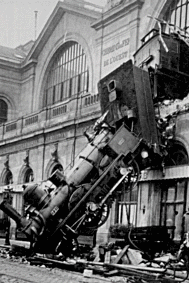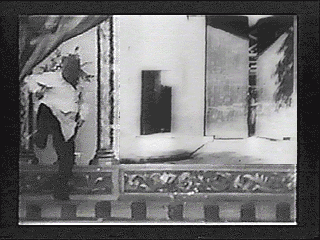
Theirs is a madness of the cinema of sorts. But there is another madness of the cinema with which most of us are familiar.
Consider the photograph and the painting.

On October 22, 1895 a train plowed through the walls of the Gare Montparnasse. Perhaps there is something crazy in the way in which the engine hangs like a fob on the end of a watch chain in the photograph, but certainly there was something frightening in the event that the photograph commemorates. People must have screamed and run away.
On the other hand, about a quarter of a century before that, the Gare Saint-Lazare
had been recreated on the stage of the Paris Revue, "with a real train
coming out of a tunnel" (Christiansen).
Did people scream and run away then? Some who had been among the music hall's
patrons would have seen the train dangling out of the Gare Montparnasse--or
the photograph. And some surely would also have been at the Grand Café
when first a train was shown arriving in a station on screen.

These days our sophistication has reached almost unimaginable bounds. Not too long ago we were too sophisticated to have screamed and run away when we saw the Lumière train. Now we are too sophisticated to believe that anyone ever did.(3) At the same time, our sophistication demands a frisson at the impossible game of miniaturization that the photograph, no less than Magritte's painting, plays. There is a confusion between Splendor and Intimacy in such a photograph: the massive, spectacular locomotive reduced to the posture and proportion of an ornament or a domestic implement. In Magritte's painting this effect is compounded by the setting, a middle class fireside. But this had also been the effect of the train on the stage--not merely enframed, but "staged" within walls, put in a scene, rendered up as sensation.
The everyday madness in these images results, at least in part, from the way in which they confuse distance: close-up and far away. What the cinema does is make that confusion worse by adding action.
Where do all the films of always-arriving trains belong in Lindsay's and in Deleuze's classificatory schema? Are they perception-images? Affection-images? Action-images? Splendor? Intimacy? Action? Long shot? Close-up? Medium shot?
Are they pictures? Stories?
Some will object that there is more than a degree of opportunism in my rhetoric. Of course, the Lumière films, and the "primitive" cinema of attractions in general were more or less deliberately excluded from what the mad poet and the philosopher wrote, because for them such images belonged properly to pre-history, a period of crude experimentation, childhood. What they said was intended to apply to the maturity of the cinema.
Look out: here comes that train again. But the cinema has never grown up. Or, to put it more accurately, the cinema never had a childhood. There is nothing primitive in the earliest film images, except in the sense of certain technological infelicities. Look left: we are off on the road to tomorrow. Their culturally-determined otherness, like much else that is culturally-determined, is figuratively as well as literally illusory. Look right: road to yesterday. In point of experience, they are as familiar to us as home-movies, as commercials, as video clips or computer screens. And what is familiar is, finally, the transformation they set in movement, being pushed forward and backward on the road to life, or utopia--from stillness to motion, from action to affect to perception, icon to index to symbol, from far away to middle distance to close-up, from story to picture, death to life, and more. Now walk straight across: meep-meep, Trans-Europe juggernaut, Chungking wheel express. What is familiar to anyone who looks at a movie is precisely what thinking images most regularly avoids: the very madness of cinema--the arrival of a train, the demolition of a wall, the opening of a door--with which we summon the délire of change.
2. This animated gif uses a series of images, out of chronology, from R. W. Paul's The Countryman at the Cinematrograph (1901) as its base and frame. However, the images that the countryman "sees" have been abducted from Sortie d'Usine, Arrivée d'un train en gare (I confess myself stumped as to which gare) and The Road to Yesterday (DeMille 1925). I like to imagine that this reconstituted countryman is actually a peasant from Garonne. Once again, this collaged animation has not been copyrighted by anyone. Back to main text.
3. See Tom Gunning. And see the rich and detailed discussion of the reception of films showing trains moving towards spectators in Yuri Tsivian. Back to main text.